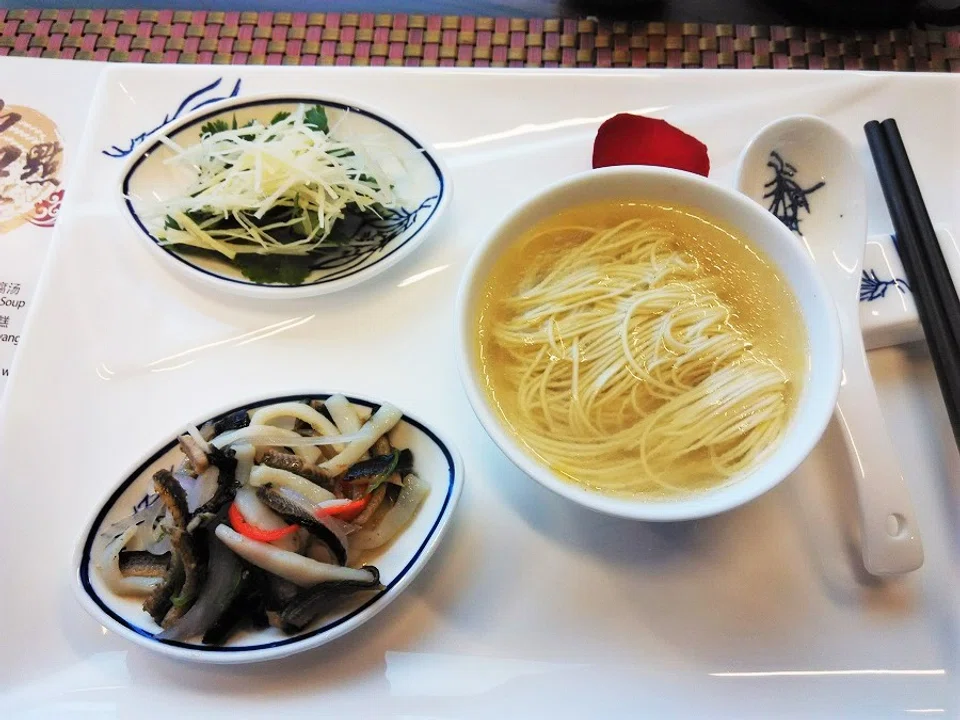Changzhou noodles: So good it evokes the wisdom of Confucius

In history, Changzhou is a famed location. It sits on the southern bank of the Yangtze River on the shore of Lake Tai, and is a neighbour of Suzhou and Zhenjiang.
Battles between the Chu state and Wu state took place on this land during the Spring and Autumn period. And in the late Spring and Autumn period, this was where King Shoumeng of Wu (吴王寿梦) crowned his fourth son Jizha the Duke of Yanling (延陵), thus Changzhou's earlier moniker of Yanling.
Changing names and boundaries
Dynastic changes give rise to changes in historical site names too. Changzhou was first called Yanling, then Piling and Jinling. It was not until the Sui and Tang dynasties that it became known as Changzhou.
By the Qing dynasty, there were eight counties under Changzhou's administration: Wujin (武进), Yanghu (阳湖), Wuxi (无锡), Jingui (金匮), Jiangyin (江阴), Yixing (宜兴), Jingxi (荆溪), and Jingjiang (靖江). Because of Changzhou's extensive jurisdiction, it was known as "an important centre of Wu culture and an administrator of eight counties" (中吴要辅, 八邑名都).
From the end of the Republic of China era until the 21st century, administrative boundaries were frequently changed, leaving Changzhou on the chopping block. Slowly, Wujin and Yanghu were removed from its jurisdiction, and so were Wuxi, Yixing, Jiangyin and Jingjiang. Today, people no longer know which areas are under the administration of Changzhou.
...official boundaries only delineate the government's power structure but not what people put in their mouths.

Snacks a form of cultural heritage
However, when it comes to Changzhou snacks, ordinary folk certainly know their stuff like the back of their hand, as if official boundaries only delineate the government's power structure but not what people put in their mouths.
During our expedition to study Changzhou's intangible cultural heritage, my Changzhou friends repeatedly stressed that we had to try Changzhou snacks since they form part of Changzhou's cultural character and heritage; a trip to study Changzhou's intangible cultural heritage was essentially a snack tour.
I asked about the characteristics of Changzhou snacks. Ji told me that they were easily available to the man on the street but tasty at the same time. He had been to Taiwan on a study of Taiwan snacks where he learnt the Taiwanese saying: "Good to eat and a big portion (好呷又大碗)". Thinking back, this describes Changzhou snacks to a T as well.
Early in the morning, we set off on our chartered bus, soon arriving at an old district in the city - perhaps near the area where Jizha was made the Duke of Yanling. We feasted on a snack banquet specially prepared for us by Changzhou's intangible cultural heritage office. Laid out on a massive 20-seater table were snacks of every variety: some were steamed, boiled, simmered or stewed, while others were stir-fried, grilled, pan-fried, deep-fried, baked, and dry-fried.

Overseas experts in the team surveyed the table like Granny Liu (a character in Dream of the Red Chamber) visiting the Grand View Gardens (大观园) for the first time. They were amazed at everything they saw and asked a thousand questions: is this glutinous rice? Is that red bean paste? Is this tofu? Are those noodles?
Ji reassured everyone: "Relax, these dishes are for display only. Dishes will be served one at a time shortly, and everyone can eat them while they're hot."
I picked up the menu on the table and saw a list of 12 snacks: soup dumplings with crab meat and roe filling, qingtuan (green glutinous rice dumplings), tangyuan (glutinous rice balls) in four flavours, sesame cake, savoury mooncakes, glutinous rice balls in sweet rice wine, black sesame soup, tofu soup, Chongyang cake, red bean paste wrapped in pork lard, coin-shaped cakes (金钱饼), and thin egg noodles (银丝面) with shredded swamp eel. The menu had everything - we just had to open our mouths and eat to our heart's content.
The restaurant owner came out to greet us and introduce each snack. He became especially excited when talking about the sesame cake, saying that everyone - regardless of social class - loved them. The sedan chair coolies and the porters of the past loved them, and so did the literati. It was even renowned Chinese modern historian Lü Simian's favourite food.
Lü had grown up near Shizi Street (十字街) and Hualongxiang (化龙巷) in Changzhou. He had fond memories of the sesame cakes from a tea house near Renyu Bridge (仁育桥, also called Mu Qiao Tou 木桥头), which was west of the street. From the time he was a little boy to the time he studied and went to school, he ate sesame cakes for breakfast every morning.
Although it is just a snack, the coin-shaped cakes are made with the utmost care.
Surprising coin-shaped cakes and refreshing noodles
The restaurant owner then introduced the coin-shaped cakes, telling us not to be fooled by its unassuming appearance, which resembled a fried mantou slice. In fact, there was much to be learnt from this snack which used to be offered up to the ancestors during the Spring Festival.
Though it is also known as the "vegetarian" bean cake (豆斋饼), its filling is pretty complex and uncommon. First, pork leg meat and shrimps are finely chopped and mixed with minced bamboo shoots to form a puree before seasoning is added. This cake is then pan-fried before it is deep-fried with its filling. During the process, whipped egg whites are used to seal the edges of the cake. Although it is just a snack, the coin-shaped cakes are made with the utmost care.

While enjoying the snacks, I realised that the Caucasian folklorists were "alien-like" academics who could find the perfect balance between learning and eating - asking questions, listening to answers, and eating at the same time. They had huge appetites as well, practically eating everything that was served without hesitation, whether it was something that flew in the sky, crawled on the ground, or swam in the water. There was nothing they dared not eat, and they were even more adventurous than the Guangdong people.
I admitted defeat after eating five, six dishes, and declared that I was bowing out and would take a back seat.
Ji asked what my favourite Changzhou snack was. There was no doubt in my mind. It had to be the thin egg noodles.
But then a bowl of thin egg noodles was served. It looked pretty refreshing, so I mustered up what was left of me and dipped my chopsticks into the bowl for a bite. As soon as I bit into it, I was amazed at how refreshing it tasted - the noodles were thin yet chewy, and a combination of Suzhou and Shanxi noodles.
I couldn't help but take another bite. Ah, how satisfying! They were indeed authentic egg noodles cooked to perfection - al dente but not too firm; pillowy but not too soft. Eating it felt like a line in Tang dynasty poet Bai Juyi's poem Ballad of the Lute (Pipa Xing,《琵琶行》): "Crisp and smooth as a yellow warbler singing under the flowers; delicate and sultry like spring water trickling through the ice."
And I was mystified by Confucius' words for some time after. Ah, its intoxicating and lingering flavour left me constantly thinking about the noodles and nothing else "for three months". (NB: When Confucius first heard Shao music in the state of Qi, he was so enchanted that he didn't know the taste of meat for three months.)
Ji asked what my favourite Changzhou snack was. There was no doubt in my mind. It had to be the thin egg noodles.
This article was first published in Chinese on United Daily News as "常州小吃" in 2016.
Related: A taste of Changzhou: Best from the rivers and lakes | China's 'latte art' from a thousand years back | When the Changzhou people made a rhyme for their sesame cake | The power of food memories in shaping who we are | Hong Kong's intangible cultural heritage and the preservation of Lingnan culture
